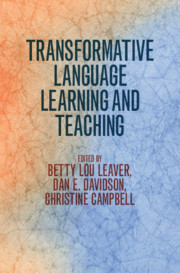Book contents
- Transformative Language Learning and Teaching
- Transformative Language Learning and Teaching
- Copyright page
- Contents
- Figures
- Tables
- Contributors
- Foreword
- Acknowledgments
- Abbreviations
- 1 Introduction
- Part I Theoretical Framework
- Part II Transformative Language Learning and Teaching Applications in Government Programs
- Part III Transformative Language Learning and Teaching Applications in University Programs
- Part IV Transformative Language Learning and Teaching Applications in Immersion Programs
- Part V The Learner
- 16 The Language Classroom as Transformative Response to the Unique Needs of Migrants and Refugees
- 17 Technology and Transformative Language Learning and Teaching
- 18 Transformation of Learners' Meaning-Making Repertoires through Classroom Instruction
- 19 Language Learner Autonomy and Transformative Classroom Practice
- 20 Cognitive and Affective Transformations in Developing Bilingual and Bicultural Competence
- Part VI Faculty Development
- Part VII Assessment
- References
- Index
19 - Language Learner Autonomy and Transformative Classroom Practice
from Part V - The Learner
Published online by Cambridge University Press: 26 January 2021
- Transformative Language Learning and Teaching
- Transformative Language Learning and Teaching
- Copyright page
- Contents
- Figures
- Tables
- Contributors
- Foreword
- Acknowledgments
- Abbreviations
- 1 Introduction
- Part I Theoretical Framework
- Part II Transformative Language Learning and Teaching Applications in Government Programs
- Part III Transformative Language Learning and Teaching Applications in University Programs
- Part IV Transformative Language Learning and Teaching Applications in Immersion Programs
- Part V The Learner
- 16 The Language Classroom as Transformative Response to the Unique Needs of Migrants and Refugees
- 17 Technology and Transformative Language Learning and Teaching
- 18 Transformation of Learners' Meaning-Making Repertoires through Classroom Instruction
- 19 Language Learner Autonomy and Transformative Classroom Practice
- 20 Cognitive and Affective Transformations in Developing Bilingual and Bicultural Competence
- Part VI Faculty Development
- Part VII Assessment
- References
- Index
Summary
This chapter traces the evolution of language learner autonomy under the impact of transformative classroom practice. It begins by summarizing Holec's definition of the concept, and then describes an approach to teaching and learning that sought to operationalize that definition, but with two added features: use of the target language for all classroom communication; and a strong emphasis on collaborative learning. This gave the concept of language learner autonomy explanatory power: learners acquire L2 proficiency when their agency is channeled through the target language. The chapter then turns to inclusive education, describing an approach to the integration of immigrant pupils that engages their agency by encouraging them to use their home languages in the classroom. This enables them to develop a capacity for agentive behavior in English and Irish with the cognitive support their home language provides. The chapter concludes by briefly associating the two learning environments described with the concept of plurilingualism as it is defined in the Common European Framework of Reference for Languages.
Keywords
- Type
- Chapter
- Information
- Transformative Language Learning and Teaching , pp. 176 - 183Publisher: Cambridge University PressPrint publication year: 2021

